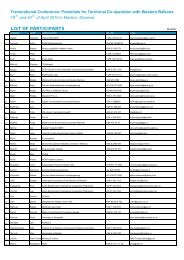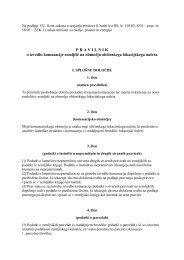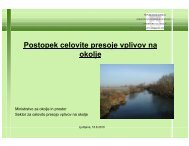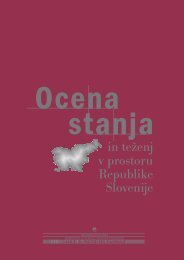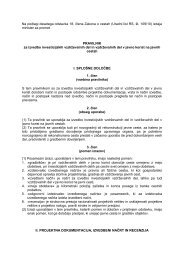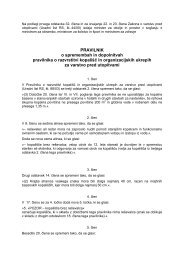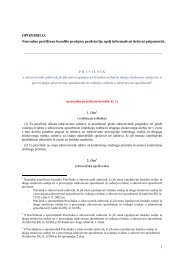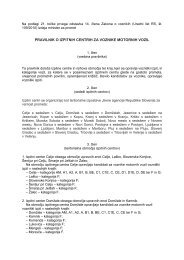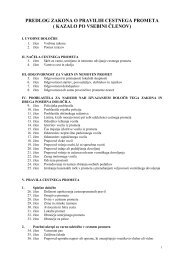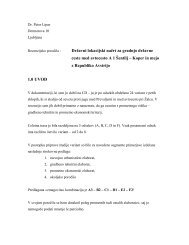evropska konvencija o krajini - Ministrstvo za infrastrukturo in prostor
evropska konvencija o krajini - Ministrstvo za infrastrukturo in prostor
evropska konvencija o krajini - Ministrstvo za infrastrukturo in prostor
Create successful ePaper yourself
Turn your PDF publications into a flip-book with our unique Google optimized e-Paper software.
228Delavnica 3 / Workshop 3V. Smernice <strong>za</strong> ohranjanje dedišč<strong>in</strong>skih kulturnihkraj<strong>in</strong>Namen smernic je predvsem podati orodja,usmeritve <strong>in</strong> pogoje <strong>za</strong> ohranjanje oziromadoseganje želenega stanja prepoznanih <strong>in</strong>ovrednotenih dedišč<strong>in</strong>skih kulturnih kraj<strong>in</strong>.Smernice, s katerimi <strong>za</strong>gotavljamo nadzorovanrežim delovanja <strong>in</strong> ravnanja v <strong>prostor</strong>u, so zeloraznolike, saj se vključujejo v različne nivojeprogramskega <strong>in</strong> <strong>prostor</strong>skega načrtovanja odstrateških do izvedbenih ravni. Glede na naravonjihovega delovanja jih lahko razvrstimo vgrobem na tri skup<strong>in</strong>e:1.) lokacijske; usmerjajo umeščanje novihrazvojnih posegov tako, da le-ti nepovzročajo razvrednotenja kulturnih kraj<strong>in</strong>. Vkolikor se presodi, da razvojni poseg nimogoče umestiti v območje brez izgubeključnih elementov oz. vrednot, <strong>za</strong>radi katerihje bila kulturna kraj<strong>in</strong>a prepoznana <strong>za</strong>kulturno dedišč<strong>in</strong>o, se s pomočjo smernicposeg preusmeri drugam.2.) strukturne; nanašajo se na vrednote, <strong>za</strong>radikaterih je bila kulturna kraj<strong>in</strong>a prepoznana <strong>za</strong>kulturno dedišč<strong>in</strong>o. Njihov namen je skrbeti<strong>za</strong> vzdrževanje želene kraj<strong>in</strong>ske zgradbe, npr.:– značilnosti <strong>in</strong> posebnosti kraj<strong>in</strong>ske zgradbe(lastnosti kraj<strong>in</strong>skih prv<strong>in</strong>: vode, vegetacije,reliefa <strong>in</strong> <strong>za</strong>konitosti njihove razporeditve v<strong>prostor</strong>u),– značilnosti parcelne delitve <strong>in</strong> <strong>prostor</strong>skihrazmerij (strnjena naselja <strong>in</strong> stiki naselb<strong>in</strong> zobdelovalnimi površ<strong>in</strong>ami, <strong>prostor</strong>ski poudarki<strong>in</strong> drobna členjenost kmetijskih površ<strong>in</strong>),– ohranitev kolikor mogoče nespremenjenegarazmerja med kulturami (trav<strong>in</strong>je, njive,sadovnjaki, gozd),– preprečevanje <strong>za</strong>raščanja kmetijskih površ<strong>in</strong><strong>in</strong> sprem<strong>in</strong>janja gozdih robov,– vzdrževanje antropogenih strukturnih prv<strong>in</strong>(terase, kamnite ograje, živice, ograje, kozolci,staje, seniki),– vzdrževanje <strong>za</strong>konitosti obstoječega omrežjapoti <strong>in</strong> druge <strong>in</strong>frastrukture,– ohranjanje značilnih tradicionalnih stavboziroma gospodarskih poslopij, razmeščenihv <strong>kraj<strong>in</strong>i</strong> v njihovi izvirni postavitvi, velikosti terrabi (kozolci, stanovi, skednji, seniki,zidanice),– nač<strong>in</strong> pove<strong>za</strong>ve s stavbno <strong>in</strong> naselb<strong>in</strong>skodedišč<strong>in</strong>o (ohranitev robov poselitve, <strong>za</strong>okrožanjeobstoječe strukture naselij, preprečevanjerazpršene pozidave),tic of it. It becomes a museum piece which onlymakes sense as an example of a past way of life,technology or characteristic. This method is onlysuitable for smaller areas <strong>in</strong> connection with anadditional educational, conservation or tourismprogramme (e. g. an open-air museum).The most realistic and vital choice is thereforethe third possibility, where we see the protectionand conservation of the cultural heritage landscapeabove all <strong>in</strong> the attempt, on the basis ofprelim<strong>in</strong>ary analysis and evaluation and withproper understand<strong>in</strong>g of the processes at work<strong>in</strong> a given landscape, to orient spatial development<strong>in</strong> a properly reasoned manner <strong>in</strong> such away that the essential landscape characteristicsthat def<strong>in</strong>e a landscape as a heritage landscapeare conserved. (Simič, 2004)Because the appearance of a cultural landscapeis shaped above all by the people who run it, effortsat conservation require the more activeparticipation of the local population, while measuresand <strong>in</strong>struments support<strong>in</strong>g developmentneed to be formulated through policies govern<strong>in</strong>gagriculture, forestry, settlement and ofcourse protection. Another major contribution tothe conservation of a cultural landscape cancome from tourism and promotion, which arebased on an emphasis<strong>in</strong>g of identity, diversityand genu<strong>in</strong>eness.V. Guidel<strong>in</strong>es for the conservation of culturalheritage landscapesThe purpose of these guidel<strong>in</strong>es is to providetools, focuses and conditions for the conservationor achievement of the desired state of recognisedand evaluated cultural heritage landscapes.The guidel<strong>in</strong>es through which we providea controlled regime of operation and action<strong>in</strong> the environment are extremely varied, s<strong>in</strong>cethey are <strong>in</strong>cluded <strong>in</strong> various levels of programmeplann<strong>in</strong>g and spatial plann<strong>in</strong>g rang<strong>in</strong>g from thestrategic to the executive. They can be roughlydivided <strong>in</strong>to three groups with regard to the natureof their operation:1.) locational; they direct the <strong>in</strong>troduction ofnew development <strong>in</strong>terventions <strong>in</strong> such away that these do not cause the devaluationof cultural landscapes. If it is judged that adevelopment <strong>in</strong>tervention cannot be <strong>in</strong>troduced<strong>in</strong> an area without the loss of key elementsor elements of value because ofwhich the cultural landscape is recognised



